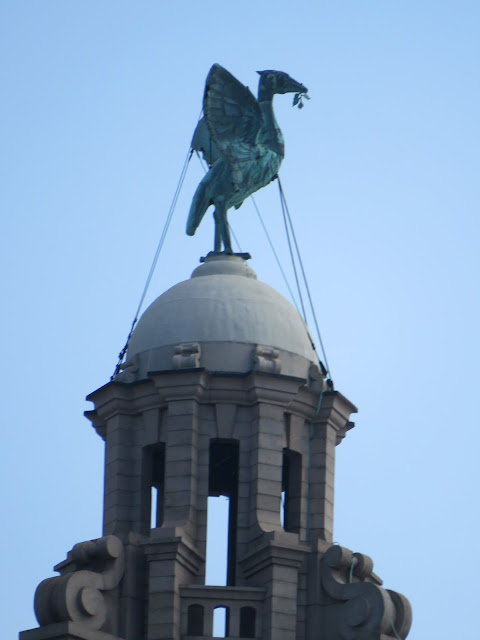After arriving in Liverpool Salthouse, and a bite to eat, we went exploring to see what was still going on at the tail end of the Tall Ships festival. There is always something to see in Liverpool, especially if you look above the shop fronts.
The landing stage at the Pier Head was crowded with motor bikes waiting for the Isle of Man Ferry to go over for the TT that is from 26th May to 8th June. There has been a constant stream of bikes down the roads too.
Behind the Liverpool Town Hall, in Exchange Flags, stands a monument to the death of Admiral Nelson at the Battle of Trafalgar 21st Oct. 1805. There are four prisoners manacled at the base that represent his four victories at the Nile, Cape St. Vincent, Copenhagen and Trafalgar and the inscription quoting what Nelson was said to signal before the Battle, England Expects Every Man to do his duty'. In two months the sum required was donated by public subscription and it was unveiled on 21st Oct 1813. It was moved to this site in 1866 and was the first public subscription statue in Liverpool.
Also in Exchange Flags is this war memorial that was erected to the memory of the members of the Exchange Newsroom that lost their lives in WWI. It was unveiled by Lord Derby on 1st Jan 1924 outsider Derby House. It was moved to this location in 1953 when the Exchange was rebuilt.
The Exchange Station was a joint venture between the East Lancs. Railway and the Lancashire and Yorkshire Railway and opened in 1850. It was rebuilt a couple of times until badly bombed in WWII but later reopened until Dr. Beeching succeeded where the Germans hadn't! There are thoughts that the HS" route may be brought to the station, but they don't make buildings like this anymore.
On Dale Street is the Prudential Building that was opened in 1886 in the Gothic Revival style. The tower was added in 1905 and make me think of an Italian church. The whole building in terracotta brick is gorgeous. It was designed by Alfred Waterhouse who built the Natural History Museum and Manchester Town Hall.
Further up Dale Street are other lovely buildings with magnificent detail on. It always pays to look up.
The Queen Victoria Monument was started in 1902 ans unveiled in 1906 and has four groups of figures round the main figure of the Queen. She doesn't look very happy, maybe it is having to hold up the orb and sceptre all these years!
The evening was lovely as it started to cool down and the crowds thinned a little with a nice light on the Echo Arena and big wheel.
The moon rose over Albert Dock and was almost full. It would be tomorrow!
It was lovely to walk by the river and see a ship leaving the Garston Channel and follow the RoRo from Birkenhead heading to sea.
As it got darker the curtain of spray right opposite our berths started and the droplets were used to project the image of a ship for the 'Ghost Ship' installation to round off a great day.





























































